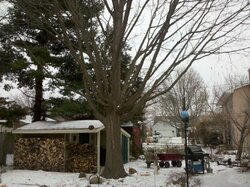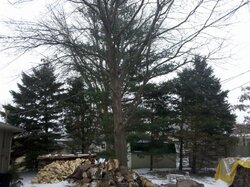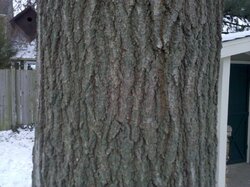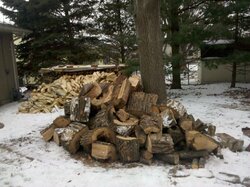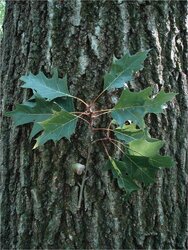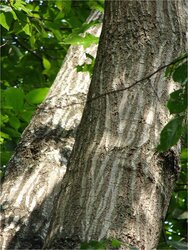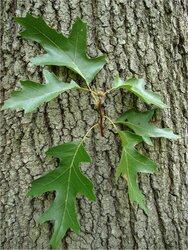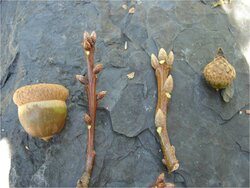I hate to admit this since I have a degree in Botany, but I never could tell the difference, for sure, between the Northern Red oak and Black Oak. I have 2 Red Oaks in my back yard, I think, that I transplanted from the woods 35 years ago. I just cut some Red Oak, I think, today. I know all the written characteristics of both, and in fact, looked them both up again tonight and am as confused as I always have been. Anybody out there have one really good distinguishing feature that only one of the 2 has? Does Black oak have the redish brown wood that Red oak has? Does the red color that shows when you chip off the bark on a red oak not there when you chip off bark on a black oak? HELP!
Red Oak or Black Oak?
- Thread starter tfdchief
- Start date
-
Active since 1995, Hearth.com is THE place on the internet for free information and advice about wood stoves, pellet stoves and other energy saving equipment.
We strive to provide opinions, articles, discussions and history related to Hearth Products and in a more general sense, energy issues.
We promote the EFFICIENT, RESPONSIBLE, CLEAN and SAFE use of all fuels, whether renewable or fossil. -
Super Cedar firestarters 30% discount Use code Hearth2024 Click here
You are using an out of date browser. It may not display this or other websites correctly.
You should upgrade or use an alternative browser.
You should upgrade or use an alternative browser.
- Status
- Not open for further replies.
Are you trying to ID firewood or standing trees? Firewood is more difficult, but Black Oak has a bright yellow or orange inner bark that you'll notice when processing the firewood. I am not sure how long this color lasts, but it is there at least a couple of months after the tree was cut. I don' think REd Oak has the same color of th inner bark, but I can't tell you from memory what the inner bark of a Northern Red Oak looks like. It must be unremarkable, or I think I'd remember, having processes lots of Northern Red and Black Oak. The wood is pretty similar. I bet experienced firewood cutters could tell the difference, but I don't know an easy way to describe the difference in the wood if there is one. The bark of Northern Red Oak has shiny raised ridges, while the bark of Black Oak is different - sort of like tire tread, no raised, shiny ridges. This can be a little hard to see if the wood is cut to firewood length, pretty distinctive on mature trees. If you have a book. you can read the differences in the leaves, but I think the bark is a far easier way to separate the trees in the field.
From a woodburning perspective I don't think it makes a difference. Both are very good firewood and very similar.
From a woodburning perspective I don't think it makes a difference. Both are very good firewood and very similar.
Wood Duck, Thanks. For years I have have tried to definitely ID Red and Black oak both from green standing trees and firewood. I always fined leaves when cutting them. I do have books as I was a Biology Teacher for 7 years. But I never end up absolutely sure....they are just to close. The trees in my back yard for example have acorns that scream red oak, but the bark has the distinctive red/orange color when you chip away at it with a knife. The leaves are so similar that with variations it's hard to tell. I know from a firewood standpoint it doesn't make much difference....I just want to know! I am cutting more red oak, I think, tomorrow. I will try to get some pics of that wood and the trees in my back yard in the next couple of days and post them....maybe Monday. Hope you can take a look at them and see what you think. Thanks, SteveWood Duck said:Are you trying to ID firewood or standing trees? Firewood is more difficult, but Black Oak has a bright yellow or orange inner bark that you'll notice when processing the firewood. I am not sure how long this color lasts, but it is there at least a couple of months after the tree was cut. I don' think REd Oak has the same color of th inner bark, but I can't tell you from memory what the inner bark of a Northern Red Oak looks like. It must be unremarkable, or I think I'd remember, having processes lots of Northern Red and Black Oak. The wood is pretty similar. I bet experienced firewood cutters could tell the difference, but I don't know an easy way to describe the difference in the wood if there is one. The bark of Northern Red Oak has shiny raised ridges, while the bark of Black Oak is different - sort of like tire tread, no raised, shiny ridges. This can be a little hard to see if the wood is cut to firewood length, pretty distinctive on mature trees. If you have a book. you can read the differences in the leaves, but I think the bark is a far easier way to separate the trees in the field.
From a woodburning perspective I don't think it makes a difference. Both are very good firewood and very similar.
Its sometimes confusing because Northern Red Oak & Black Oak will sometimes hybridize & are found in the same locales,especially here in the Midwest. I can sometimes tell them apart and then will see a couple trees either close by or some distance away & those will have me stumped,no pun intended.Both species are used for the same purposes,from fuel to furniture,veneer,flooring,pallets,charcoal etc. As a general rule though,Black Oak tends to have a shorter trunk,even when growing in a closed forest,with more limbs/knots.
Thistle, I have run across the hybridize literature as well....and I believe that really complicates the ID. As for the shorter trunk, my 2 red oaks in my back yard are considerably different in structure although the leaves and acorns are exactly the same. One has a typical red oak growth structure and the other has a short trunk...goes up maybe 7 - 8 feet, then all branches seem to come out and go up from there....no main trunk after that. Is that what you and the books are talking about regarding a shorter trunk? Maybe I have one Red and one Black oak in my back yard :roll: Again, I will try to get some pics on here in the next couple of days. Thanks, SteveThistle said:Its sometimes confusing because Northern Red Oak & Black Oak will sometimes hybridize & are found in the same locales,especially here in the Midwest. I can sometimes tell them apart and then will see a couple trees either close by or some distance away & those will have me stumped,no pun intended.Both species are used for the same purposes,from fuel to furniture,veneer,flooring,pallets,charcoal etc. As a general rule though,Black Oak tends to have a shorter trunk,even when growing in a closed forest,with more limbs/knots.
I remember from my dendrology class at Penn state that we used to differentiate black oak from red oak by scratching the bark and looking for the bright orange or yellow color (which indicates black oak). if I remember right, red oak had a brick brown color when you scratched the bark. When looking at the leaves red oak leaves have more lobes than black oak. A single tree of either species will have leaves with varying numbers of lobes, red oak leaves have more lobes, although there is some overlap, but if you see a tree that has some leaves with 9 or more lobes then it is likely a red oak. These two species are hard to tell apart at times. Bark can be similar on both tree, but a younger red oak will have smooth bark, and an older black oak will have bark that is very dark in color. Id'ing these trees is kinda like piecing a puzzle together, they can be very similar. That's why i think the bark scratching test is the easiest way
Thanks for the tips,everyone. Now I vaguely remember the last time I was cutting some live but storm damaged red/black oak a while back.There was some orange -yellowish cast on the inner bark where it peeled or was knocked away.Even when I talked to my District DNR Forester at State Fair last summer he gave me the same info.Its good to have that info,cause its not always reliable to ID certain trees in winter,even after almost 30 yrs of stomping through the woods.
I can't tell the difference either. When I was a kid, all the old-timers used to refer to the oak trees around here as red oak. Then maybe about 20 years ago, people started referring to them as black oak, saying that they weren't red oak. And these are the same trees that were here when the old guys were still alive.
But one thing I know for sure is that when we go to sell any of them for timber, the guys from the harvesting companies always take one quick glance and say; "Those are all black oak and black oak isn't worth as much as red oak." Imagine that....
But one thing I know for sure is that when we go to sell any of them for timber, the guys from the harvesting companies always take one quick glance and say; "Those are all black oak and black oak isn't worth as much as red oak." Imagine that....
When doing that scratch test you really don't even need to get deep into the bark, scrap the bark a little with a pocket knife and you will see that color. And if you really can't tell when you are looking at a tree just call it a red oak, black oak does fall into the broad red oak family, along with northern red, southern red, pin oak etc.
My brother-in-law says that if the oak tree holds its' leaves through the winter it is a black oak.. Red oak drops its' leaves.. Anyone ever hear that? My oaks hold most of their dead leaves even in the strongest wind and drop them in the spring when the new leaf buds form..
Ray
Ray
One of my forestry professors in college told me to check the buds. Black Oak are hairy while Red Oak are not. Hard to do if the tree is really tall!
Ok, I have read that many times but with conflicting descriptions of the color.....One source says Red oaks display a brick red color in the bark when scratched with a knife. The same source says that the black oak bark displays a yellow/orange color when scratched, and still other sources say that only the black oak shows any significant color when scratched. My red oaks in my back yard show a brick red color under the bark and as you describe you don't have to go very deep.krex1010 said:When doing that scratch test you really don't even need to get deep into the bark, scrap the bark a little with a pocket knife and you will see that color. And if you really can't tell when you are looking at a tree just call it a red oak, black oak does fall into the broad red oak family, along with northern red, southern red, pin oak etc.
Sounds like you have red oaks then. As far as I know black oaks are the only oaks with that yellow/bright orange color
I promised pics of my Red Oaks in the back yard. Here are they are. One has the traditional Red Oak canopy and the other has a short trunk like described for black oaks, but everything else about them seems to be the same....So what do you guys think, Red or Black. Also a close up of the bark and the big red oak I just cut.....or at least I think it is Red.
Attachments
The grooves in the bark might be a little shallower looking than the black oaks I have here. Otherwise, except for that really odd clump of branches growing out of that one tree, it looks like every black oak I've ever cut. (the same ones that the old-timers always said were red)
All oaks are either "red" or "white". Red oak contains red oak, black oak, turkey oak, etc etc. The red, black, turkey and a bunch of those are so similar that it doesn't really make a difference in wood terms. The swamp oaks and weird ones are the wild cards.
Quads, Now I am really confused. I had decided mine were Red for sure....oh well, it doesn't really matter, just something I have always wanted to figure out. I can identify most trees, but telling for sure whether red or black has always escaped me. :coolsmirk:quads said:The grooves in the bark might be a little shallower looking than the black oaks I have here. Otherwise, except for that really odd clump of branches growing out of that one tree, it looks like every black oak I've ever cut. (the same ones that the old-timers always said were red)
Are you sure it's either red or black? LOL
From: http://www.timberteam.com/uploads/files/oak.pdf
Red Oak Group (Erythrobalanus)
Quercus coccinea-bastard oak, black oak, buck oak, red oak, scarlet oak, Spanish oak, spotted oak
Quercus falcata-American red oak, bottomland red oak, cherrybark oak, Elliott oak, red oak, Spanish oak, southern red oak,
swamp red oak, swamp spanish oak, turkeyfoot oak, water oak
Quercus kelloggii-black oak, California black oak, Kellogg oak, mountain black oak
Quercus laurifolia-Darlington oak, diamond-leaf oak, laurel oak, laurel-leaf oak, swamp laurel oak, water oak, obtusa oak
Quercus nigra-American red oak, blackjack, pin oak, possum oak, punk oak, red oak, spotted oak, water oak
Quercus nuttallii-nuttall oak, pin oak, red oak, red river oak, striped oak
Quercus palustris-pin oak, red oak, Spanish oak, Spanish swamp oak, Spanish water oak, swamp oak, swamp Spanish oak,
water oak
Quercus phellos-black oak, laurel oak, peach oak, pin oak, red oak, swamp willow oak, water oak, willow oak, willow swamp oak
Quercus rubra-American red oak, black oak, buck oak, Canadian red oak, common red oak, gray oak, eastern red oak, leopard
oak, Maine red oak, mountain red oak, northern red oak, red oak, Spanish oak, spotted oak, southern red oak, swamp red oak,
water oak, West Virginia soft red oak
Quercus shumardii-American red oak, Schneck oak, Schneck red oak, shumard oak, Shumard red oak, southern red oak,
spotted bark, spotted oak, swamp red oak, Texas oak, Texas red oak
Quercus velutina-American red oak, blackjack, black oak, dyer oak, jack oak, quercitron, quercitron oak, redbush, red oak,
smoothbark oak, spotted oak, tanbark oak, yellowbark, yellow oak, yellowbark oak
From: http://www.timberteam.com/uploads/files/oak.pdf
Red Oak Group (Erythrobalanus)
Quercus coccinea-bastard oak, black oak, buck oak, red oak, scarlet oak, Spanish oak, spotted oak
Quercus falcata-American red oak, bottomland red oak, cherrybark oak, Elliott oak, red oak, Spanish oak, southern red oak,
swamp red oak, swamp spanish oak, turkeyfoot oak, water oak
Quercus kelloggii-black oak, California black oak, Kellogg oak, mountain black oak
Quercus laurifolia-Darlington oak, diamond-leaf oak, laurel oak, laurel-leaf oak, swamp laurel oak, water oak, obtusa oak
Quercus nigra-American red oak, blackjack, pin oak, possum oak, punk oak, red oak, spotted oak, water oak
Quercus nuttallii-nuttall oak, pin oak, red oak, red river oak, striped oak
Quercus palustris-pin oak, red oak, Spanish oak, Spanish swamp oak, Spanish water oak, swamp oak, swamp Spanish oak,
water oak
Quercus phellos-black oak, laurel oak, peach oak, pin oak, red oak, swamp willow oak, water oak, willow oak, willow swamp oak
Quercus rubra-American red oak, black oak, buck oak, Canadian red oak, common red oak, gray oak, eastern red oak, leopard
oak, Maine red oak, mountain red oak, northern red oak, red oak, Spanish oak, spotted oak, southern red oak, swamp red oak,
water oak, West Virginia soft red oak
Quercus shumardii-American red oak, Schneck oak, Schneck red oak, shumard oak, Shumard red oak, southern red oak,
spotted bark, spotted oak, swamp red oak, Texas oak, Texas red oak
Quercus velutina-American red oak, blackjack, black oak, dyer oak, jack oak, quercitron, quercitron oak, redbush, red oak,
smoothbark oak, spotted oak, tanbark oak, yellowbark, yellow oak, yellowbark oak
The bark picture doesn't look like any red oak I have around me. I think Red Oak has very distinctive bark too. Honestly though I don't see black oak that often to be 100% sure of myself.
Thanks, joshlaugh, sounds like one more vote for black oak. This summer, with leaves, buds, and acorns, I swear I'm going to figure this out for SURE! I know it doesn't really matter but I want to know. >:-(joshlaugh said:The bark picture doesn't look like any red oak I have around me. I think Red Oak has very distinctive bark too. Honestly though I don't see black oak that often to be 100% sure of myself.
I always get to the fun posts late 
IDing oaks can be hard - but always possible.
Northern Red oak usually has a ski slope looking stripey pattern to the bark at least on the upper part of the trunk - and usually the whole trunk on smaller trees. Big old trees can have thick deeply furrowed bark. Black oaks won't have the ski stripey bark usually. their bark is overall more chunky in appearance to red oaks.
for leaves, black oak usually has 5 or 7 lobes and the lobes tend to be more squared off at the ends. northern red oak leaves will 'usually' have 7 or more lobes and are thinner at the ends of the lobes and angle more towards the front of the leaf - whereas black oak lobes are less angled - i.e. closer to perpendicular to the midvein of the leaf.
If you want to tell for absolute sure - in the winter you have to look at the buds.
as someone else mentioned, the bud at the end of a black oak twig is big and light colored and fuzzy - on a northern red oak, its much smaller and reddish and not fuzzy.
and don't feel bad - the arboretum at the university I work at has a black oak labeled as a northern red oak. I've told them about it but they haven't changed the label.

IDing oaks can be hard - but always possible.
Northern Red oak usually has a ski slope looking stripey pattern to the bark at least on the upper part of the trunk - and usually the whole trunk on smaller trees. Big old trees can have thick deeply furrowed bark. Black oaks won't have the ski stripey bark usually. their bark is overall more chunky in appearance to red oaks.
for leaves, black oak usually has 5 or 7 lobes and the lobes tend to be more squared off at the ends. northern red oak leaves will 'usually' have 7 or more lobes and are thinner at the ends of the lobes and angle more towards the front of the leaf - whereas black oak lobes are less angled - i.e. closer to perpendicular to the midvein of the leaf.
If you want to tell for absolute sure - in the winter you have to look at the buds.
as someone else mentioned, the bud at the end of a black oak twig is big and light colored and fuzzy - on a northern red oak, its much smaller and reddish and not fuzzy.
and don't feel bad - the arboretum at the university I work at has a black oak labeled as a northern red oak. I've told them about it but they haven't changed the label.
oh yeah, and the acorns - do you have acorns - very very different.
here, I found some pictures I took a few years ago, this should help.
first picture will be northern red oak
second picture will be bark of northern red oak further up on the tree
third picture will be black oak
fourth picture will be a comparison of acorns and twigs of northern red and black oaks with the red on the left and black on the right.
here, I found some pictures I took a few years ago, this should help.
first picture will be northern red oak
second picture will be bark of northern red oak further up on the tree
third picture will be black oak
fourth picture will be a comparison of acorns and twigs of northern red and black oaks with the red on the left and black on the right.
Attachments
Looking at those pics, I think it is possible that at least one may be scarlet oak. Scarlet oak can often look like a combo of black and red oak, often looking like a black oak in the lower third of the tree and a red oak in the upper portions. Have any pics of the leaves? That coupled with the pics you have up should show enough to really get a good Id on what kind of oaks you have theretfdchief said:I promised pics of my Red Oaks in the back yard. Here are they are. One has the traditional Red Oak canopy and the other has a short trunk like described for black oaks, but everything else about them seems to be the same....So what do you guys think, Red or Black. Also a close up of the bark and the big red oak I just cut.....or at least I think it is Red.
- Status
- Not open for further replies.
Similar threads
- Replies
- 4
- Views
- 363
- Replies
- 25
- Views
- 5K


